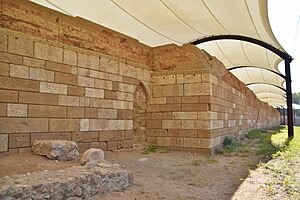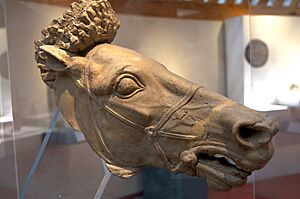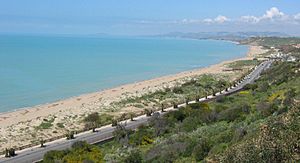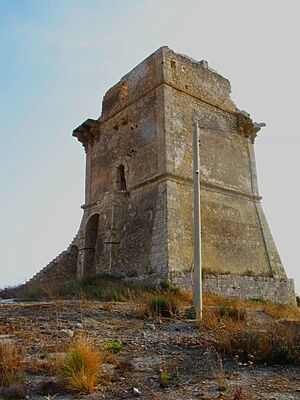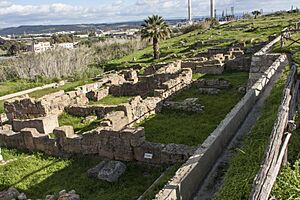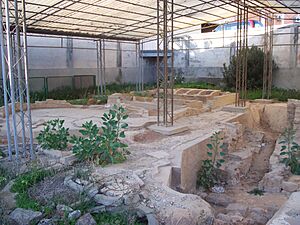Gela facts for kids
Quick facts for kids
Gela
|
||
|---|---|---|
| Comune di Gela | ||
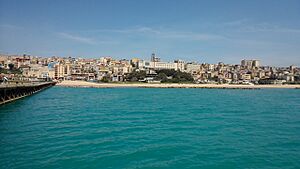
Gela town from the pier
|
||
|
||
| Country | Italy | |
| Region | Sicily | |
| Province | Caltanissetta (CL) | |
| Frazioni | Manfria | |
| Area | ||
| • Total | 276 km2 (107 sq mi) | |
| Elevation | 46 m (151 ft) | |
| Population
(31 August 2017)
|
||
| • Total | 75,001 | |
| • Density | 271.7/km2 (703.8/sq mi) | |
| Demonym(s) | Gelesi | |
| Time zone | UTC+1 (CET) | |
| • Summer (DST) | UTC+2 (CEST) | |
| Postal code |
93012
|
|
| Dialing code | 0933 | |
| Patron saint | St. Maria dell'Alemanna | |
| Saint day | 8 September | |
Gela is a city and a comune (which means municipality or town) located in the Autonomous Region of Sicily, Italy. It is the largest town on the southern coast of Sicily in terms of both land area and population. Gela is part of the Province of Caltanissetta. It is one of the few towns in Italy that is bigger than its provincial capital, Caltanissetta.
Gela was founded a very long time ago, in 698 BC. It was started by Greek settlers, called colonists, who came from Rhodes and Crete. Back then, it was an important polis (an ancient Greek city-state) in a region the Greeks called Magna Graecia. This area included southern Italy and Sicily. Gela grew to be one of the most powerful cities until the 5th century BC. Aeschylus, a very famous Greek writer of plays, lived here and passed away in 456 BC. Much later, in 1943, during World War II, the Allied forces landed in Gela. This was their first step in the invasion of Sicily.
Contents
A Look at Gela's Past
Ancient Gela: A Powerful Greek City
Archaeologists have found proof that people lived on the acropolis (the highest part of the city) of Gela as far back as the Copper Age, around 4,000 BC. People also lived there during the Bronze Age, around 2,000 BC.
The city of Gela was officially founded around 688 BC. This was about 45 years after the city of Syracuse was founded. The Greek colonists chose to build their new city on the northern slope of a hill called Molino a Vento.
Gela got its name from the Gela river. The word gela in the local Sicilian language means "winter frost." According to an ancient historian named Diodorus Siculus, the city was founded by two leaders, Antiphemus and Entimus.
Right away, Gela had conflicts with the Sicani, who were native people of the area. Antiphemus led a war against a nearby Sicani city called Omphace. The people of Gela won this war. They even took a special statue that was believed to have been made by the legendary sculptor Daedalus.
In the 7th century BC, the Temple of Athena Lindia was built on the acropolis. Athena was the protector goddess of the city. This first temple was later made part of a second, larger temple in the 6th century BC, also dedicated to Athena.
The Greeks set up many colonies in Magna Graecia, and for centuries, they had a big impact on the area. Gela became very successful. Its leaders, especially Cleander and Hippocrates, wanted Gela to expand. They helped Gela create new towns, like Akragas (now Agrigento). They also took control of several other cities, including Leontini (Lentini) and Naxos (Sicily) (Giardini-Naxos). Only Syracuse managed to stay independent, with help from its founding city, Corinth.
When Kamarina, a colony of Syracuse, rebelled in 492 BC, Hippocrates of Gela stepped in to fight Syracuse. He defeated the Syracusan army and surrounded their city. However, he was convinced to leave in exchange for control of Kamarina. Hippocrates died in 491 BC in a battle against the Siculi, another native Sicilian group.
Hippocrates was followed by Gelon. In 484 BC, Gelon conquered Syracuse and decided to move his government there. His brother, Hiero, was given control over Gela. Later, when Theron of Agrigento conquered Himera and a Carthaginian army arrived in Sicily, Gela and Syracuse were asked for help. Gelon and Hiero won a big victory in the Battle of Himera. The Carthaginian leader, Hamilcar, died in this battle.
After Gelon died in 478 BC, Hiero moved to Syracuse. Many people from Gela who had moved to Syracuse came back to their home city. Gela regained some of its power. The famous playwright Aeschylus died in Gela in 456 BC.
In 425 BC, during the Sicilian wars, Gela was an ally of Syracuse. Even though Kamarina was usually an ally of Gela, it was on the opposing side in this war. The two cities decided to stop fighting. They then invited all the warring cities to meet and discuss peace. In 424 BC, at the Congress of Gela, the Sicilian cities agreed to peace. Their motto was "Sicily for the Sicilians."
Gela also fought against the Athenian attempt to conquer the island in 415 BC. This event is known as the Sicilian Expedition.
In 406 BC, the Carthaginians conquered and destroyed Agrigento. Gela asked for help from Dionysius I of Syracuse. But Dionysius did not arrive in time. The next year, Gela was destroyed and its treasures were stolen. The people who survived fled to Syracuse. In 397 BC, they returned to Gela and joined Dionysius II in his fight for freedom from the invaders. By 383 BC, Gela's independence was recognized.
Timoleon rebuilt the city walls in 338 BC after the Carthaginians had destroyed them. The acropolis, which used to be a sacred area, became a place where houses were built. The main important area of the city moved to Capo Soprano.
Under Agathocles (317-289 BC), Gela faced problems between its people and the aristoi (the wealthy aristocrats). When the Carthaginians arrived in 311 BC, they easily took the city with the help of the aristoi. The acropolis at Molino a Vento was then completely abandoned.
Around 282 BC, Phintias of Agrigento is said to have destroyed Gela to stop its power forever. He moved its people to his new city of Phintias, near where Licata is today. However, some historians believe that the Mamertines were the ones who truly destroyed Gela, five years earlier.
Roman, Byzantine, and Medieval Times
After this, Gela was not mentioned much in historical records. Under Roman rule, a small settlement still existed. It was mentioned by famous writers like Virgil and Pliny the Elder. Later, it was a small center during the Byzantine Empire. When the Arabs controlled the area, it was known as the "City of Columns."
A new city called "Terranova" was founded in 1233 by Frederick II. This name was used until 1928. The new settlement was built west of ancient Gela. It had a castle and strong walls. Terranova was owned by the king until 1369. Then, King Frederick III of Aragon gave it to Manfredi III Chiaramonte. But in 1401, after Andrea Chiaramonte betrayed the king, the city was taken back. It was then given to several Aragonese noble families. In 1530, the title of Marquis of Terranova was created for Giovanni Tagliavia Aragona. In 1561, his son Carlo became the Duke. The Terranova Aragona family controlled the city until 1640. After that, it passed to the Pignatelli family, who held it until 1812.
Gela in Modern Times
Terranova was renamed Terranova di Sicilia. In 1927, it was officially renamed Gela.
During World War II, on July 9, 1943, the U.S. 1st Infantry Division and the 82nd Armored Reconnaissance Battalion landed on the beaches of Gela. These beaches were strongly defended by the Italian Livorno Division. The Allied forces fought off an Italian and German armored attack in the Battle of Gela. The U.S. Army Engineers built several airfields near the city. These were used by the Twelfth Air Force during the Italian Campaign.
After the war, a large oil refinery was built in Gela. This was part of Eni's plan to help the economy in Southern Italy. However, the refinery caused a lot of damage to the area's natural beauty and made it less appealing for tourists. Because of this, the refinery was closed down in 2014.
Where is Gela?
Gela is located on the Mediterranean coast. It is at the mouth of the Gela river on the southwestern side of Sicily. The towns next to Gela are Acate, Butera, Caltagirone, Mazzarino, and Niscemi. Its coastal village, or frazione, is Manfria. In geology, the Gelasian Age of the Pleistocene Epoch is named after Gela.
Gela's Climate
Gela has a Mediterranean climate. This means its winters are mild and rainy, while its summers are dry and hot. Most of the rain falls in autumn and winter.
| Climate data for Gela (1991–2020, extremes 1965–present) | |||||||||||||
|---|---|---|---|---|---|---|---|---|---|---|---|---|---|
| Month | Jan | Feb | Mar | Apr | May | Jun | Jul | Aug | Sep | Oct | Nov | Dec | Year |
| Record high °C (°F) | 22.0 (71.6) |
23.4 (74.1) |
27.6 (81.7) |
33.2 (91.8) |
34.6 (94.3) |
38.0 (100.4) |
41.4 (106.5) |
40.0 (104.0) |
34.4 (93.9) |
33.0 (91.4) |
28.4 (83.1) |
23.6 (74.5) |
41.4 (106.5) |
| Mean daily maximum °C (°F) | 15.5 (59.9) |
15.5 (59.9) |
16.8 (62.2) |
19.2 (66.6) |
22.6 (72.7) |
26.0 (78.8) |
28.3 (82.9) |
29.1 (84.4) |
26.9 (80.4) |
24.0 (75.2) |
20.2 (68.4) |
16.8 (62.2) |
21.7 (71.1) |
| Daily mean °C (°F) | 12.2 (54.0) |
12.1 (53.8) |
13.4 (56.1) |
15.8 (60.4) |
19.3 (66.7) |
22.9 (73.2) |
25.3 (77.5) |
26.3 (79.3) |
23.9 (75.0) |
21.0 (69.8) |
17.2 (63.0) |
13.7 (56.7) |
18.6 (65.5) |
| Mean daily minimum °C (°F) | 9.1 (48.4) |
8.7 (47.7) |
10.0 (50.0) |
12.2 (54.0) |
15.9 (60.6) |
19.9 (67.8) |
22.4 (72.3) |
23.4 (74.1) |
20.9 (69.6) |
17.9 (64.2) |
14.1 (57.4) |
10.7 (51.3) |
15.4 (59.7) |
| Record low °C (°F) | 0.0 (32.0) |
0.0 (32.0) |
0.0 (32.0) |
3.8 (38.8) |
5.8 (42.4) |
11.0 (51.8) |
13.6 (56.5) |
15.6 (60.1) |
12.4 (54.3) |
7.8 (46.0) |
2.4 (36.3) |
1.8 (35.2) |
0.0 (32.0) |
| Average precipitation mm (inches) | 83.7 (3.30) |
59.1 (2.33) |
46.6 (1.83) |
34.7 (1.37) |
12.0 (0.47) |
7.9 (0.31) |
2.9 (0.11) |
3.9 (0.15) |
48.3 (1.90) |
68.3 (2.69) |
87.5 (3.44) |
84.2 (3.31) |
539.2 (21.23) |
| Average precipitation days (≥ 1.0 mm) | 7.4 | 6.8 | 5.6 | 4.4 | 2.3 | 1.0 | 0.3 | 0.6 | 3.7 | 5.0 | 7.5 | 8.0 | 52.4 |
| Average relative humidity (%) | 74.4 | 72.9 | 73.8 | 72.3 | 70.9 | 69.8 | 70.2 | 71.5 | 73.5 | 74.2 | 74.0 | 73.8 | 72.6 |
| Average dew point °C (°F) | 8.2 (46.8) |
7.8 (46.0) |
9.5 (49.1) |
11.5 (52.7) |
14.6 (58.3) |
17.9 (64.2) |
20.3 (68.5) |
21.5 (70.7) |
19.7 (67.5) |
16.9 (62.4) |
12.8 (55.0) |
9.4 (48.9) |
14.2 (57.6) |
| Mean monthly sunshine hours | 185.4 | 186.2 | 230.6 | 255.6 | 307.5 | 325.5 | 357.4 | 335.7 | 263.4 | 225.1 | 188.1 | 173.3 | 3,033.9 |
| Source 1: NOAA | |||||||||||||
| Source 2: Servizio Meteorologico (extremes) | |||||||||||||
| Climate data for Gela Osservatorio delle Acque elevation 9 m (29.5 feet) (1981-2010) | |||||||||||||
|---|---|---|---|---|---|---|---|---|---|---|---|---|---|
| Month | Jan | Feb | Mar | Apr | May | Jun | Jul | Aug | Sep | Oct | Nov | Dec | Year |
| Mean daily maximum °C (°F) | 17.2 (63.0) |
17.3 (63.1) |
18.9 (66.0) |
21.4 (70.5) |
25.1 (77.2) |
28.4 (83.1) |
30.9 (87.6) |
31.7 (89.1) |
29.3 (84.7) |
26.4 (79.5) |
22.0 (71.6) |
18.2 (64.8) |
23.95 (75.11) |
| Mean daily minimum °C (°F) | 8.6 (47.5) |
8.4 (47.1) |
9.8 (49.6) |
11.9 (53.4) |
15.9 (60.6) |
19.7 (67.5) |
22.4 (72.3) |
23.2 (73.8) |
20.9 (69.6) |
17.7 (63.9) |
13.2 (55.8) |
10.0 (50.0) |
15.14 (59.25) |
| Average precipitation mm (inches) | 57.1 (2.25) |
39.4 (1.55) |
34.5 (1.36) |
25.3 (1.00) |
14.0 (0.55) |
5.5 (0.22) |
2.5 (0.10) |
8.7 (0.34) |
28.5 (1.12) |
68.3 (2.69) |
56.1 (2.21) |
60.7 (2.39) |
398.2 (15.68) |
| Source: Blog di recordpiana [1] | |||||||||||||
What to See in Gela
Gela has many interesting places to visit, especially if you like history and nature:
- Greek Acropolis: This is the ancient high part of the city where important buildings once stood.
- The Regional Archeological Museum: Here you can see many artifacts found in Gela, telling the story of its past.
- Archaeological Site of Capo Soprano: This area has the famous Timolean walls, which are ancient city walls from the 4th century BC. They are named after Timoleon, who rebuilt them. This site is in a large park between the modern city and the coast. Many beautiful Attic vases found here are now in different museums.
- Zona Sacra: This "sacred area" includes the foundations of three Greek temples. The oldest one has an 8-meter-tall Doric column still standing. This column is one of the symbols of Gela. Remains of an ancient market (emporium) from the 7th–6th centuries BC have also been found here.
- The Cathedral: This church is dedicated to the Holy Virgin Assunta. It was rebuilt between 1766 and 1794 on top of an older small church. It has a beautiful front with Doric and Ionic columns. Inside, you can see an 18th-century painting called Transit of the Virgin.
- San Francesco d'Assisi Church: This church was updated in the 17th century. It has a painted wooden roof and a painting showing the Deposition by Vito D'Anna.
- The Castelluccio: This "Small Castle" was built in the early 13th century. It is about 10 km from the city.
- Natural Reserve of Biviere di Gela: This nature reserve includes a coastal lake surrounded by sand dunes.
- Manfria: This area has a typical beach with Mediterranean dunes and the Torre di Manfria (Manfria Tower).
Archaeological Discoveries
There are three main archaeological areas in Gela that you can visit: Capo Soprano, the Acropolis, and the Bosco Littorio site.
At Capo Soprano, you can see the best-preserved example of Greek military architecture in the world: the Timolean city walls. These walls, almost 400 meters long, date back to the 4th century BC. What makes them special is their lower part, made of large squared blocks of stone (Calcarenite) that are 3 meters high. Above this, there was a thick layer of sun-dried clay bricks, which are still perfectly preserved. This upper layer was probably added quickly when news came of an upcoming Carthaginian invasion. In some places, the walls were almost 10 meters tall on the outside. They are considered one of the most important discoveries in classical archaeology of the 20th century. They show how much the ancient Greeks cared about defensive design and engineering. The walls were designed by an architect with great detail, including features for protection from weather, towers, stairs, walkways, and drains. Inside the walls, a military area with clay brick buildings has been found. Not far away, a large living area from the same time has also been discovered.
The Acropolis stretches between the Gela river mouth and the Pasqualello valley. It contains the ruins of houses, shops, temples, and the Hippodamian road system. This system includes main streets (plateia) and smaller side streets (stenopoi). The sacred area was to the north. Today, you can only see the bases of three temples. From the largest one, Temple C or Athenaion, a Doric-style column (almost 8 meters tall) is still standing. This column is one of the city's symbols. Until 405 BC, the acropolis held the most important sacred buildings of Gela. But after the Carthaginians destroyed the city, houses were built over the acropolis when Timoleon came to power.
In Bosco Littorio, south of the Acropolis, a large market complex (emporium) from the 7th–6th century BC has recently been found and restored. This complex was near the port at the river's mouth and included workshops, warehouses, and shops.
A grand Hellenistic villa has been found in via Romagnoli (predio Iacona).
The Greek baths of Gela in via Europa are unique in Sicily. They have two rooms. The one to the northwest has two groups of bathtubs connected by a wastewater system. The bathtubs in the first group are shaped like a horseshoe. While two seats from this group are missing, all the upper halves of the second group's seats are gone, perhaps never finished. The tubs were made from a mix of terracotta pieces and sandstone.
Recent discoveries in the area include:
- The oldest Greek shipwreck (from 500 BC), which is very special. It will be shown in the Museum of Navigation.
- In 2009, a fourth ancient boat was found near the mouth of the Dirillo river, on the coast of the Bulala district. The other three boats are in the Museum of Ancient Navigation.
- Foundations of two more Greek temples: a very large one next to the crypts of the Mother Church, and another near the new multi-story car park in via Istria.
- A grand villa from the Hellenistic period on the Capo Soprano promontory, with views of the gulf.
In 2019, a sarcophagus (a stone coffin) with a complete skeleton was found in Gela. A few weeks later, nearby, a ceramic water jug containing the bones of a newborn baby and parts of a large animal's skeleton was discovered. Archaeologists believe this area was definitely a Greek burial ground.
Sister Cities
Gela is twinned with these cities:
Sports in Gela
Football
Gela has its own football team called S.S.D. Città di Gela. Their home stadium is Stadio Vincenzo Presti. The team was first founded in 1975 and has been re-founded several times since. Their best performance in Italian football was finishing 12th in Group B of the 2010–11 Lega Pro Prima Divisione.
Famous People from Gela
See also
 In Spanish: Gela para niños
In Spanish: Gela para niños




